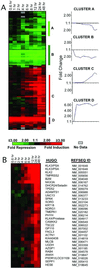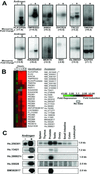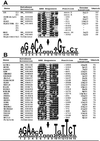The program of androgen-responsive genes in neoplastic prostate epithelium
- PMID: 12185249
- PMCID: PMC129364
- DOI: 10.1073/pnas.182376299
The program of androgen-responsive genes in neoplastic prostate epithelium
Abstract
The human prostate gland is an important target organ of androgenic hormones. Testosterone and dihydrotestosterone interact with the androgen receptor to regulate vital aspects of prostate growth and function including cellular proliferation, differentiation, apoptosis, metabolism, and secretory activity. Our objective in this study was to characterize the temporal program of transcription that reflects the cellular response to androgens and to identify specific androgen-regulated genes (ARGs) or gene networks that participate in these responses. We used cDNA microarrays representing about 20,000 distinct human genes to profile androgen-responsive transcripts in the LNCaP adenocarcinoma cell line and identified 146 genes with transcript alterations more than 3-fold. Of these, 103 encode proteins with described functional roles, and 43 represent transcripts that have yet to be characterized. Temporal gene expression profiles grouped the ARGs into four distinct cohorts. Five uncharacterized ARGs demonstrated exclusive or high expression levels in the prostate relative to other tissues studied. A search of available DNA sequence upstream of 28 ARGs identified 25 with homology to the androgen response-element consensus-binding motif. These results identify previously uncharacterized and unsuspected genes whose expression levels are directly or indirectly regulated by androgens; further, they provide a comprehensive temporal view of the transcriptional program of human androgen-responsive cells.
Figures



References
-
- Prins G S. Mayo Clin Proc. 2000;75:S32–S35. - PubMed
-
- Eder I E, Culig Z, Putz T, Nessler-Menardi C, Bartsch G, Klocker H. Eur Urol. 2001;40:241–251. - PubMed
-
- Huggins C, Hodges C V. Cancer Res. 1941;1:293–297.
-
- Bonkhoff H, Remberger K. Prostate. 1996;28:98–106. - PubMed
-
- Isaacs J T, Lundmo P I, Berges R, Martikainen P, Kyprianou N, English H F. J Androl. 1992;13:457–464. - PubMed
Publication types
MeSH terms
Substances
Grants and funding
LinkOut - more resources
Full Text Sources
Other Literature Sources
Medical
Molecular Biology Databases

